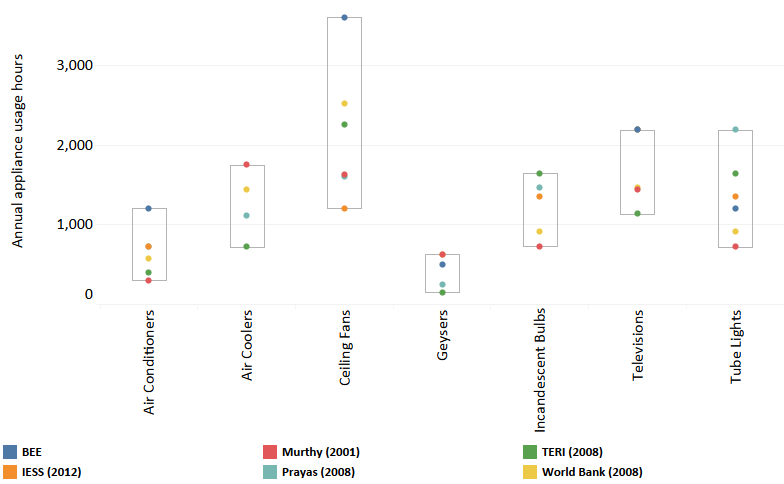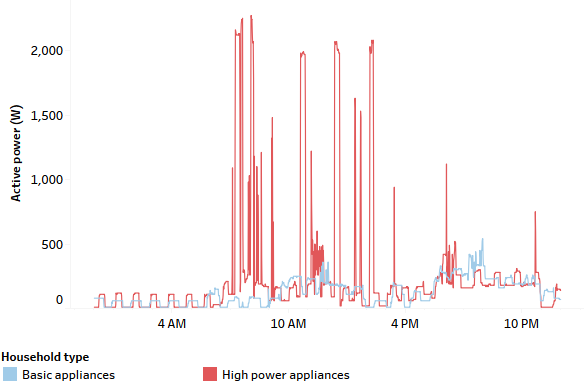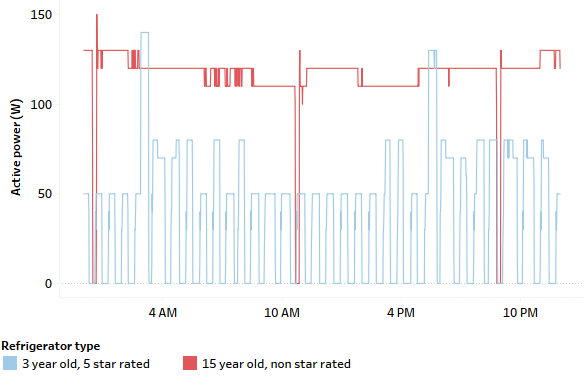
This is the eighth post in the blog series “Plugging in: Electricity consumption in Indian Homes” by Prayas (Energy Group) and Centre for Policy Research (CPR).
When and how do people use different household appliances in a day? This is an important question for electricity distribution companies that supply the electricity required to run these appliances. For instance, if the use of air-conditioners shoots up on a particularly hot summer afternoon, then the distribution company will have to buy additional electricity to meet the demand at that particular time. An equally important consideration for utilities and households is the electricity consumption of appliances in actual operating conditions, compared to the manufacturers’ claims made under laboratory conditions. In this post, we look at broad appliance usage patterns observed in India and briefly discuss new work on measuring the actual use of electricity in households.
Households’ use of appliances depends on a number of factors such as income, climate, and behavioural tendencies, among others. There is limited understanding of the household level use of different appliances in India and its variation across socio-economic conditions and geography. Studies that project India’s residential electricity consumption assume nation-wide, uniform usage hours based on few local load research studies. There is a wide variation between these usage hours’ assumptions as seen in Figure 1.

Figure 1: Compilation of usage hours of appliances from different studies
Source: Prayas (Energy Group), Residential Electricity Consumption in India: What do we know? December 2016
The load research studies estimate appliance usage patterns based on household surveys and load analysis of residential feeders. The Bureau of Energy Efficiency (BEE) under its capacity building programme commissioned about 30 such load research studies for public sector distribution companies all over India in 2015. However, these reports are not yet public, and a better understanding of appliance ownership and usage remains partial.
While surveys provide relatively low cost means to gather insights into various aspects like appliance ownership and purchase patterns, accuracy of information on actual electricity consumption can be limited. This is because of two key reasons: (a) respondents may have difficulty in recalling the actual use of appliances; and (b) the actual power consumption of appliances may be different from the rated power consumption claimed by the manufacturer. In order to address this gap, we have initiated a project to install metering devices in a sample of households to measure electricity consumption every minute and send the data to a central server. These devices will measure the aggregate household electricity consumption and consumption from selected key appliances. We have started with Pune and will eventually extend to other urban, semi-urban, and rural areas in India. Daily (anonymous) consumption patterns recorded by these meters will be periodically updated on a publically accessible website. The project builds on our existing electricity supply monitoring initiative which measures and publishes the quality of electricity supply in about 300 locations across the country.
We briefly describe insights based on initial data recorded from selected households in Pune below.
- · People use different appliances at different times of the day. Load curves of households show the variation of electricity drawn by the household from the grid over the length of the day. Electricity distribution companies prefer a flatter load curve as it eases their supply operations. However, appliances like the air-conditioner, electric water-heater, and microwave oven can add significant peak demand. As the ownership of these appliances increase, it will be crucial for the distribution companies to understand the cumulative impact of their use on the load curve. Figure 2 shows the difference between the load curve of a household owning basic appliances and the load curve of a household owning high power appliances. Basic appliances include lighting, fans, and the refrigerator and high power appliances include an additional air-conditioner, electric-water heater and microwave oven.

Figure 2: Comparison of load curves between households with basic appliances with high power appliances like air-conditioner, electric water-heater, and microwave oven, in addition to basic appliances.
Source: Data recorded by Prayas (Energy Group)
- Refrigerators accounted for about 25% to 50% of the total electricity consumption of the selected households. This may change in the summer when ceiling fans, air-coolers and air-conditioners are used more. We found a significant variation in the actual electricity consumption of the refrigerators across homes. One 15-year old refrigerator consumed 4 times more electricity than a 3-year old 5-star refrigerator of same type and size. On an annual basis, this can mean the old refrigerator consumes about 1200 units (kWh) of electricity (contributing to the electricity bill with Rs. 6000-7000) compared to 300 units (about Rs. 1500-1800) by the new, efficient refrigerator. Load curves of both refrigerators (Figure 3) throw more light on this. The compressor, which consumes most of the electricity, is always on in the old refrigerator while it draws less power and periodically switches off in the new refrigerator, thus consuming less electricity. This may be because of the usage habits (frequent opening of the refrigerator door) or deteriorated performance of the working parts of the refrigerator.

Figure 3: Load curves for refrigerators
Source: Data recorded by Prayas (Energy Group)
Such insights can be useful across different stakeholder groups. They help distribution utilities understand the cumulative impact of high power appliances like air-conditioners and electric water-heaters on the load curve. Actual consumption data from a sample of appliances can also be used to design campaigns that highlight the magnitude of real impacts of energy efficiency on consumer electricity bills. The BEE, which is responsible for running the Standards and Labeling (S&L) programme, can use the data to modify the procedures and ratings to represent the actual consumption of appliances more accurately. Finally, manufacturers can use the data to understand the performance of their products under actual operating conditions.
In the next, final, post of this series, we examine the role of behavior in how appliances are used.
This piece is authored by Aditya Chunekar at Prayas (Energy Group), Pune.
This blog series is also available on the Centre for Policy Research website.

